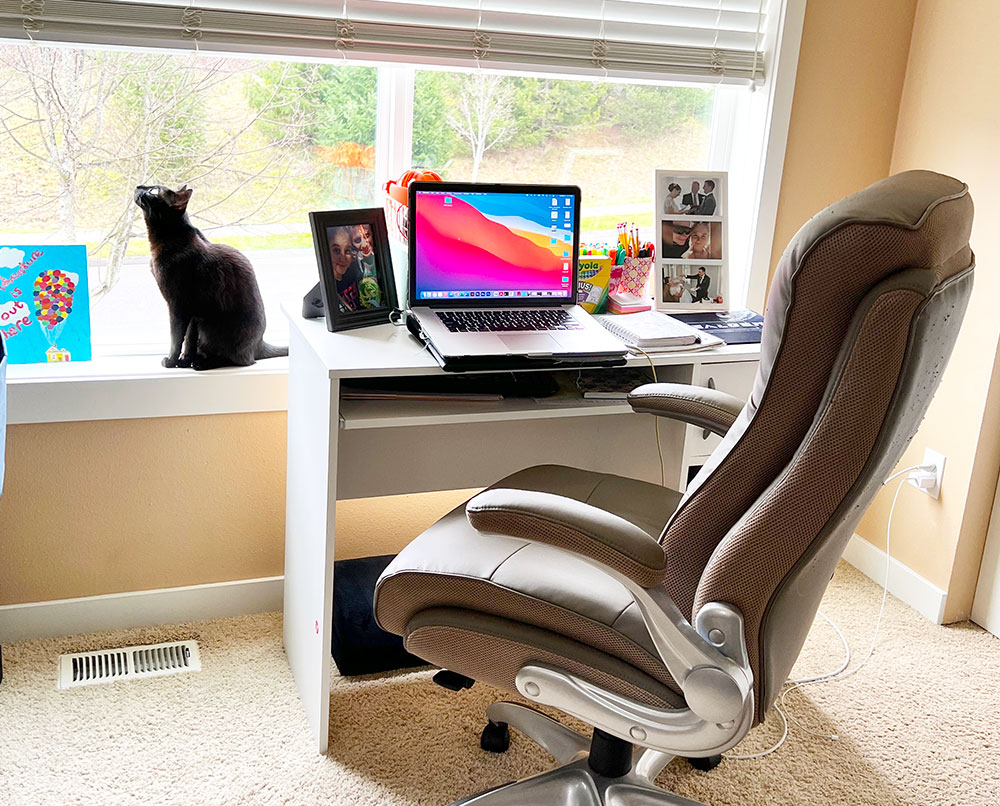
Remote work seemed like a dream before the COVID-19 pandemic hit.
I was so over spending more than an hour commuting each day to make it to and from the office. It just seemed like such a waste of time (not to mention gas money) for a job that barely paid over minimum wage.
But what really got me? I knew I could easily do my job from home.
That realization came to millions of Americans (and corporations) once the pandemic hit. But, as I found out when I quit my old job and started working for Bragg Media, making the transition from office work to remote work was harder than I thought it would be.
It took some serious adjusting — and self-discipline — to be successful and stay motivated as a remote worker. But once you figure it out, working from home really can be the dream we all imagined.
 Website Design
Website Design
Affordable website design with a process that works for you.
1. Set up a REAL office space.
This is the first lesson I learned when working from home — you really do need to set up a dedicated office space and USE IT. As comfortable as that couch is, you’re so much more likely to be distracted and less productive when you sit there. (Not to mention how rough crouching over your laptop on the couch is for your body).
It doesn’t necessarily have to be a traditional desk and office chair, but it’s better to create a space that you ONLY use for work. That brings me to my next point:
2. Set some boundaries for yourself.
Working from home shouldn’t mean that there’s zero separation between your work life and your personal life. Set some boundaries for yourself!
These boundaries could be:
- Making set work hours
- Creating a separate work phone number
- Not putting your work email on your cell phone
- Keeping that separate office space
The key here is making sure that work doesn’t take over your life just because you’re now working remotely. You should still have set hours and days off of work. So if that means you need a separate work number and you don’t answer it after 5 p.m. or on weekends, then do that. But remember to try to keep some work-life balance, even when you’re working from home.
3. Change out of those PJs
I know they’re comfortable, but I personally feel so much better and more productive when I change out of my pajamas — even if it’s just into a clean pair of PJs or sweatpants and a t-shirt.
While you don’t necessarily need to dress up or put makeup on, keeping some kind of morning routine can be really beneficial to your productivity. So get up, brush your teeth, fix your hair, wash your face, put on some clean clothes — whatever works for you.
4. Make a to-do list
On my busier weeks, it really helps to make a to-do list either for the whole week or just for the day. My personal routine is to pull out my daily planner while I have my morning coffee. On Mondays, I’ll attempt to plot out daily tasks for the whole week. But each morning I’ll take another look at my planner and make adjustments as needed.
If you’re overwhelmed trying to schedule the whole week, try just making a new list each morning. It’s a great way to keep organized and set expectations for yourself.
5. Make a routine
One thing you lose when you switch to remote work is that daily routine. So it’s important to create a new one.
The whole changing out of your pjs and creating a morning routine is a start. But I personally am a lot more productive when I establish a full-day routine. For me, that means I’ve basically made a full schedule for myself. I know what time I need to start work each day, and have a general time frame of when I want to be finished.
6. Take breaks.
Just like when you worked in an office, breaks should be a part of the routine you create for yourself. Give yourself time to eat lunch, to go for a walk, to do some yoga — whatever you need to stay comfortable and productive.
7. Communication is key.
Sure, you can’t walk across the office to your coworkers’ desks anymore. But that doesn’t mean you should communicate less.
There are a ton of ways to stay in touch with your coworkers when working remotely. You can set up Google calendars, use the Google chat option for quick questions, or use Slack or another internal communication platform.
8. Learn when it really needs to be an email, phone call or Zoom meeting.
The whole “that could’ve been an email” meme really is valid.
Even though it’s super important to keep open communication with your coworkers and clients when working remotely, it’s also important to learn when it really needs to be a Zoom meeting or when it could just be a quick email or phone call.
I will argue that regular Zoom meetings (or Google video or another virtual meeting platform) are important. It’s still good to get in some “face time” on occasion. But just like not everything needed to be a meeting in the office, some things really can be a quick chat via a messaging platform, a phone call, or a regular old email.
9. Know that sick days are still valid
This goes along with the whole “setting boundaries” thing — work-life balance is important. And just because you might be capable of working from home when you’re sick, doesn’t mean you don’t need a day off every once in a while.
Sure, if you just have a mild cold and feel okay for the most part, remote work might be the thing that allows you to work without fear of getting others sick. But if you feel like you need a day off, take it. Mental health days are valid as well.
When you’re sick, your body really does need rest — and just because you seem “physically capable” of sitting in your bed doing work that day, it doesn’t mean you should.
10. Take advantage of the extra time you have for yourself.
Beyond just taking the same types of breaks you would have during the work day in the office, try to really take advantage of the whole “working from home” situation.
You don’t have a commute now, so give yourself time to enjoy breakfast or at least a cup of tea or coffee in the morning before you start working. If you have extra time during your lunch break, go for a walk, do some yoga or a quick workout, or even take a nap if you need to.
Obviously, this last part will depend on how your job works — if you still have a rigid hourly schedule where you have to virtually clock in and out at specific times, you won’t have as much leeway. But if you’re setting your own schedule, try to make a routine that really works to your advantage. Not only can you improve your physical and mental health this way, but you can also boost your productivity and overall work performance.

Ashley Francis
Bragg Media Marketing Specialist
Ashley is a multi-skilled marketing ninja. From graphic design to content writing, she can use both sides of her brain.
